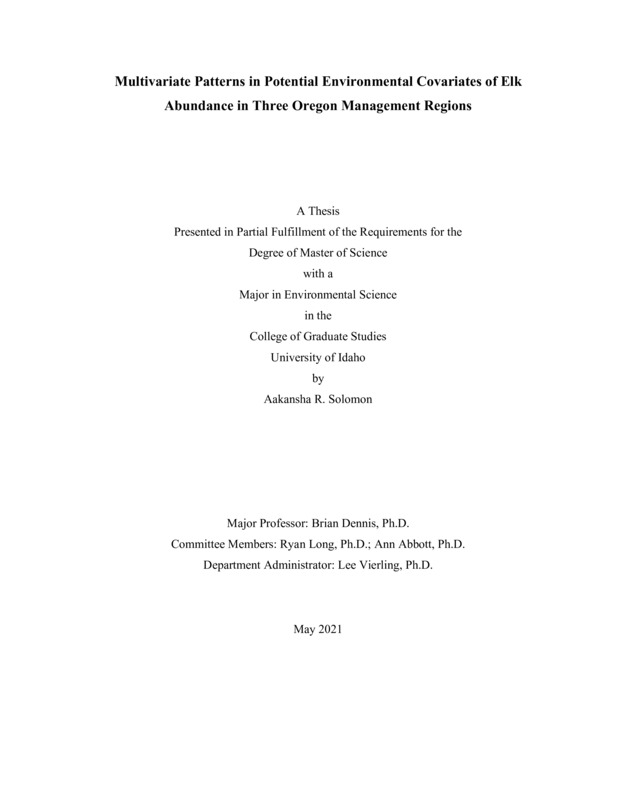Multivariate Patterns in Potential Environmental Covariates of Elk Abundance in Three Oregon Management Regions
Solomon, Aakansha. (2021-05). Multivariate Patterns in Potential Environmental Covariates of Elk Abundance in Three Oregon Management Regions. Theses and Dissertations Collection, University of Idaho Library Digital Collections. https://www.lib.uidaho.edu/digital/etd/items/solomon_idaho_0089n_12109.html
- Title:
- Multivariate Patterns in Potential Environmental Covariates of Elk Abundance in Three Oregon Management Regions
- Author:
- Solomon, Aakansha
- Date:
- 2021-05
- Keywords:
- bottom-up Cervus elaphus Northeast Oregon population abundance Puma concolor top-down
- Program:
- Environmental Science
- Subject Category:
- Wildlife management
- Abstract:
-
The purpose of this study was to evaluate top-down and bottom-up effects controlling elk (Cervus elaphus) recruitment by making inferences concerning the predator-prey dynamics of elk and mountain lions (Puma concolor) inhabiting Northeast Oregon ecosystems. We formulated hypotheses about the environmental drivers of the number of elk observed in annual surveys, bulls per hundred cows, and calves per hundred cows in annual surveys of three elk populations in Northeast Oregon. The study analyzed key environmental factors gathered from 1962-2007 which potentially control the elk population growth rate in three management units: the Snake, Wenaha, and Desolation areas. The study was conducted using principal component analysis, canonical correlation analysis, and multiple regression analysis to determine covariates to characterize potential top-down and bottom-up effects which defined elk abundance and recruitment in all three management units. Overall, in Wenaha area, 70% of variation in elk recruitment as measured by calf to cow ratios was induced by the cougar abundance and total elk harvest. In the Snake and Desolation areas respectively, 54% and 40% of the variation in elk abundance was explained by the cougar abundance and harsh weather climate. The correlation patterns in the Snake unit was consistent with additive mortality from predation while the patterns in the Wenaha unit was consistent with compensatory mortality from predation. The Desolation unit was consistent with both the additive and compensatory mortality from predation. Elk biologists and managers could conduct field research from these findings to test methods of preventing elk populations from declining in Northeast Oregon. Key words: top-down, bottom-up, Cervus elaphus, Puma Concolor, Northeast Oregon, population abundance
- Description:
- masters, M.S., Environmental Science -- University of Idaho - College of Graduate Studies, 2021-05
- Major Professor:
- Dennis, Dr. Brian
- Committee:
- Abbott, Dr. Ann; Long, Dr. Ryan
- Defense Date:
- 2021-05
- Identifier:
- Solomon_idaho_0089N_12109
- Type:
- Text
- Format Original:
- Format:
- application/pdf
- Rights:
- In Copyright - Educational Use Permitted. For more information, please contact University of Idaho Library Special Collections and Archives Department at libspec@uidaho.edu.
- Standardized Rights:
- http://rightsstatements.org/vocab/InC-EDU/1.0/

